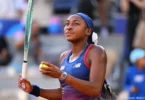Shocking News 😔 😔: Emma Raducanu Warned to Silence Haters as Tennis Insider Blasts Her for Prioritizing Fame Over Tennis Amidst Controversies Due To…
Emma Raducanu’s meteoric rise to fame in 2021, culminating in her historic US Open victory, positioned her as one of tennis’s brightest young stars. However, the subsequent years have seen the British athlete embroiled in a series of controversies and criticisms, with many questioning her commitment to the sport and alleging that she prioritizes fame over her tennis career. This article delves into the multifaceted challenges Raducanu has faced, the criticisms leveled against her, and the broader implications for young athletes navigating the complex interplay between professional sports and public scrutiny.
The Meteoric Rise and Subsequent Scrutiny
In 2021, at just 18 years old, Raducanu made history by becoming the first qualifier to win a Grand Slam title in the Open Era, clinching the US Open without dropping a single set. This unprecedented achievement catapulted her into the global spotlight, bringing with it not only adulation but also heightened expectations and scrutiny. The sudden fame led to numerous sponsorship deals with high-profile brands such as Dior, Nike, and Vodafone, significantly increasing her public profile and financial earnings.
However, with the accolades came criticisms. Some observers argued that Raducanu’s focus had shifted from her tennis career to capitalizing on her newfound fame. Critics pointed to her numerous commercial engagements as evidence that she was prioritizing endorsements over training and performance. This narrative was further fueled by her struggles on the court post-US Open, where she faced early exits in several tournaments and battled recurring injuries.
Criticisms and Controversies
A significant point of contention has been Raducanu’s frequent coaching changes. Since her US Open triumph, she has parted ways with multiple coaches, leading to speculation about her commitment and decision-making process. Some analysts argue that these changes indicate a lack of stability and question her dedication to developing a consistent training regimen. For instance, after parting ways with coach Nick Cavaday due to his health issues, Raducanu has been temporarily assisted by former mentors, such as Roman Kelecic and Jane O’Donoghue, while considering long-term coaching options. There is speculation whether Raducanu will choose someone familiar or seek new input. She might also hire two coaches to distribute the workload, a common approach among top players.
Additionally, her decision to accept a main draw wildcard for the Abu Dhabi Open sparked debate. Critics argued that she was bypassing the traditional qualifying process, leading to accusations of entitlement. This move was perceived by some as an attempt to leverage her fame for favorable treatment, further fueling the narrative that she prioritizes her public image over the sport.
Furthermore, Raducanu’s public statements have occasionally drawn ire. For example, she described herself as a “dangerous player” despite a series of early tournament exits and injuries. This self-assessment was met with skepticism, with some labeling her as “entitled” and “delusional.” Critics argued that her confidence was misplaced and indicative of a disconnect between her self-perception and on-court performance.
Defenses and Support
In response to the criticisms, several figures within the tennis community have come to Raducanu’s defense. Former British tennis player Naomi Broady emphasized that those labeling Raducanu’s US Open win as a “fluke” fail to grasp the complexities of the sport. Broady highlighted the challenges of maintaining peak physical condition and the time required for a young athlete to adjust to the demands of professional tennis.
Raducanu herself has addressed the scrutiny, stating that criticism is an inherent part of success. She remarked, “I think when they’re not talking about you, that’s when you need to start to worry.” This perspective underscores her understanding of the media landscape and the inevitability of public commentary in the life of a high-profile athlete.
Moreover, Raducanu has acknowledged the challenges of balancing her commercial commitments with her tennis career. She admitted that managing sponsorship obligations alongside training and competition was a learning curve. This acknowledgment reflects her awareness of the need to find equilibrium between leveraging her marketability and maintaining her athletic performance.
The Broader Context: Fame, Youth, and Professional Sports
Raducanu’s experiences highlight the broader challenges faced by young athletes who achieve sudden fame. The transition from relative obscurity to global recognition can be overwhelming, with pressures stemming from public expectations, media scrutiny, and the demands of sponsors. Balancing these elements while striving to maintain peak performance in a highly competitive environment is a formidable task.
The criticisms directed at Raducanu also raise questions about the expectations placed on young female athletes. There appears to be a double standard in how male and female athletes are perceived when engaging in commercial activities. While male athletes often receive praise for securing lucrative endorsements, female athletes may face criticism for allegedly prioritizing fame over their sport. This disparity points to underlying gender biases in the evaluation of athletes’ professional choices.
The Path Forward
For Raducanu, the path forward involves navigating these multifaceted challenges with resilience and strategic planning. Securing a stable coaching arrangement could provide the consistency needed to hone her skills and develop a sustainable training regimen. Additionally, setting clear boundaries around commercial engagements may help her maintain focus on her athletic goals.
It’s also essential for Raducanu to manage public expectations and communicate her journey transparently. By sharing insights into her decision-making processes and the challenges she faces, she can foster a more nuanced understanding among fans and critics alike.
Furthermore, the tennis community and media must recognize the pressures faced by young athletes and approach their coverage with empathy and fairness. Constructive criticism is valuable, but





